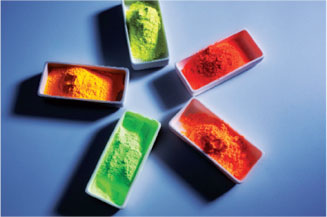Phosphors

Phosphors are in myriad applications, including biofluorescent labels, display devices, plus LED and light bulb coatings. Phosphors emit brightly relative to other materials and present a different apparent color depending on their composition. Cathodoluminescence (CL) in the electron microscope is an ideal technique for evaluating phosphor luminescence because interaction with the focused electron beam can generate luminescence signals from individual phosphor particles, even those as small as a few nanometers in size, to allow investigation of variations between phosphor particles.
CL spectroscopy helps analyze many different phosphors, including individual nanometer-sized crystals of Y1.98Tb0.02O2S and Gd1.98Tb0.02O2S. In those studies, photon emission maps demonstrate a high degree of uniformity. Spectra from the two materials also show an identical intensity ratio between the 5D3 → 7FJ and 5D4 → 7FJ transitions, which is important evidence that the concentration of (activated) Tb3+ cations is very similar in these different crystals. Other researchers are developing these nanometer-sized phosphors as stable biological labels under electron beam illumination.